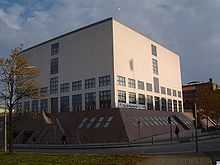Oswald Mathias Ungers
| Oswald Mathias Ungers | |
|---|---|
| Born |
July 12, 1926 Kaisersesch, Germany |
| Died |
September 30, 2007 (aged 81) Cologne, Germany |
| Nationality | German |
| Buildings |
Messe-Torhaus, Frankfurt Wallraf-Richartz Museum, Cologne |
Oswald Mathias Ungers (July 12, 1926 – September 30, 2007) was a German architect and architectural theorist, known for his rationalist designs and the use of cubic forms. Among his notable projects are museums in Frankfurt, Hamburg and Cologne.
Biography
Oswald Mathias Ungers was born in Kaisersesch in the Eifel region. From 1947 to 1950 he studied architecture at the University of Karlsruhe under Egon Eiermann. He set up an architectural practice in Cologne in 1950, and opened offices in Berlin in 1964, Frankfurt in 1974 and Karlsruhe in 1983.
He was a professor at the Technical University of Berlin from 1963 to 1967 and served as the dean of the faculty of architecture from 1965 to 1967. In 1968 he moved to the United States, where he became the chair of the department of architecture at Cornell University from 1969 to 1975. In 1971 he became a member of the American Institute of Architects. He was also a visiting professor at Harvard University (1973 and 1978) and the University of California, Los Angeles (1974/75). He returned to Germany in 1976, becoming a visiting professor at the University of Applied Arts Vienna (1979/80) and a full professor at the Kunstakademie Düsseldorf (1986).
Oswald Mathias Ungers died on September 30, 2007 from pneumonia. He was married to Liselotte Gabler (1926–2010) and had one son (Simon Ungers) and two daughters.
Selected projects
- 1979–1984 German Architecture Museum in Frankfurt
- 1980–1983 Messe-Torhaus in Frankfurt
- 1983–1991 Badische Landesbibliothek in Karlsruhe
- 1986 Former main building of the Alfred Wegener Institute for Polar and Marine Research in Bremerhaven
- 1993–1996 Friedrichstadt-Passagen (Quartier 205) in Berlin
- 1994 Residence of the German ambassador in Washington D.C.
- 1994–1995 Haus ohne Eigenschaften in Cologne
- 1995 Museum of Contemporary Art in Hamburg
- 1998–2001 Dorotheenhöfe, Berlin
- 2001 Wallraf-Richartz Museum in Cologne
- 2006 Entrance to the ruins of a Roman bath in Trier
- Proposed or under construction
- In 2000, he won an architectural competition to redesign the Pergamon Museum in Berlin. His controversial plan proposes large alterations to the building complex which has remained unchanged since 1930. The rebuilding is scheduled to end in 2010.
-

Museum of Contemporary Art in Hamburg
-

Messe-Torhaus in Frankfurt
-

Badische Landesbibliothek in Karlsruhe
-

Alfred Wegener Institute in Bremerhaven
-

Deutsches Architekturmuseum in Frankfurt
Writings
- Entwerfen mit Vorstellungsbildern, Metaphern und Analogien. Anmerkungen zu einem morphologischen Konzept, in: Architektur 1951-1990, Stuttgart, 1991
- Morphologie. City Metaphors, König, 1982
- Die Thematisierung der Architektur, 1983, published by Technische Universität Dortmund and Walter A.Noebel, Niggli Verlag, 2009, ISBN 978-3-7212-0698-2
- The Dialectic City, Skira Editore, 1997
External links
| Wikimedia Commons has media related to Oswald Mathias Ungers. |
- Official homepage of the Ungers Archives for Architecture
- Obituary in The Times, 8 October 2007
- Obituary in The Guardian, 18 October 2007
|

